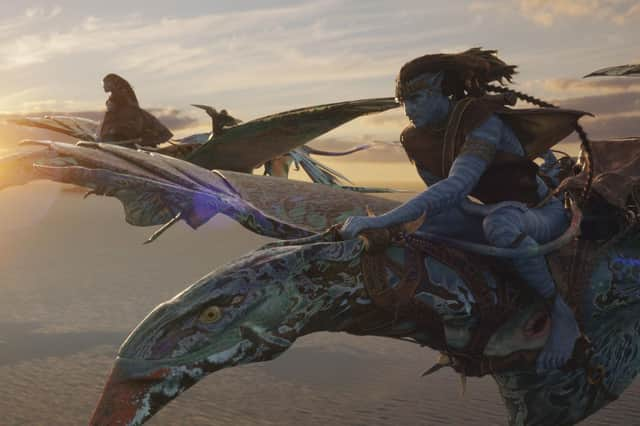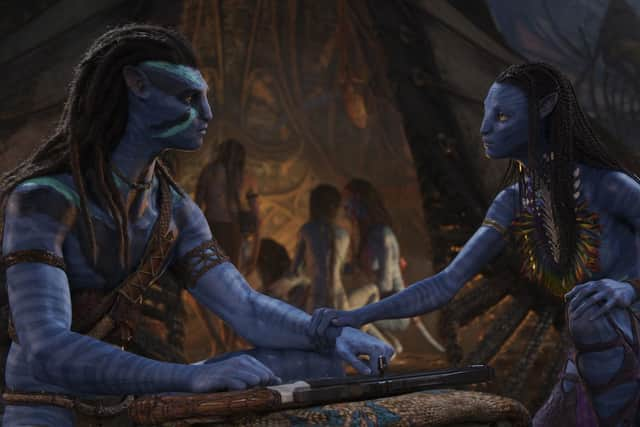Film review: Avatar: The Way of Water


Avatar: The Way of Water (12A) **
Although James Cameron is responsible for making three of the best and most influential sci-fi films of the blockbuster age, the original Avatar isn’t one of them. It may have trumped Cameron’s own Oscar-sweeping Titanic to become the highest-grossing film of all time, yet for all its supposed technological breakthroughs, it was disappointingly derivative, filled with unmemorable characters, cringe-worthy dialogue and that’ll-do-plotting (remember “unobtanium”?), all of which begged the question: where did the James Cameron who wrote and directed The Terminator, Aliens and Terminator 2: Judgment Day go?
The answer to that is not forthcoming in Avatar: The Way of Water. Thirteen years on, the sequel that desperate cinema-chain owners are hyping as the “movie event of a generation” isn’t even the movie event of the year – although the first ten minutes do deliver on some of the claims Cameron prematurely made for the first film back in 2009. Returning us to the verdant world of Pandora, with its floating mountain ranges, hanging waterfalls and bioluminescent plant life, the 3D is crisp and clear and genuinely something to look at as fantastical image after fantastical image pops off the screen. It helps too that Cameron seems to have solved the High Frame Rate problem that gave Peter Jackson’s Hobbit trilogy and Ang Lee’s Gemini Man the cheap-looking aesthetic of live TV. It may not quite look like a movie in the traditional sense, but it doesn’t not look like a movie either, its pin-sharp visuals falling somewhere between a high-end Blue Planet or NASA documentary and a top-of-the-line video game.
Advertisement
Hide AdIt’s a shame, then, that the Thundercat-like Na’vi also have to make a return. As quickly becomes evident, all the tech advances in the world can’t hide the narrative tedium of watching Cameron’s yoked-together eco-fable unfurl over 190 minutes. Picking up the story almost in real time, Sam Worthington’s paraplegic marine Jake Sully, now fully merged with his giant feline avatar (but still talking in clichés), has apparently spent the intervening years living a kind of pseudo-mystical, warrior-chief existence, defending the Na'vi against more waves of plundering “sky people” while also procreating with his true-blue love, Neytiri (once again played by Zoe Saldaña).
We quickly learn they’ve got four kids: three Na’vi/human crossbreeds and one immaculately conceived adopted daughter. The latter comes courtesy of Sigourney Weaver’s comatose Na'vi avatar, a plot devolvement that raises many awkward questions that the film isn’t ready to grapple with. Instead its extensive narrative real estate is largely occupied by these kids getting their own angst-ridden subplots, including one involving a rogue, whale-like sea creature that turns the film into a goofy riff on Free Willy, the resulting action all too likely to inspire fits of derisory laughter at the sight of a teenage Na'vi and a despondent sea creature commiserating with each other about the pain of being misunderstood outsiders.
If the story seems even more adolescent this time out, though, that’s because Cameron doesn’t seem to have any good ideas for creating tension other than repeatedly putting multiple kids in peril to provide Jake and his Na’vi brethren with some plot motivation. “I can’t believe I’m being tied up again,” says Jake’s youngest at one point, a lame attempt at self-referential humour that you have to remind yourself has come from the minds of three blue-chip screenwriters (in addition to Cameron, the screenplay was cowritten by Rise of the Planet of the Apes writers Rick Jaffa and Amanda Silver). Nor is it just Jake and Neytiri’s kids being used as plot bait. After they’re forced to flee their home and take up with a tribe of free-diving Na’vi-adjacent sea creatures known as the Metkayina, we’re introduced to a whole new set of adolescent hostages-in-waiting. And that’s after the film has already introduced us to yet another kid, human this time, who’s destined to play a big role in the story and whose parentage is revealed in an opening recap of the first film’s plot, despite never being mentioned in the first film at all.
Elsewhere Cameron introduces a new threat to the Na’vi by merging the avatar technology with human cloning to bring back Stephen Lang’s badass Colonel Quaritch, the leader of a colonising force who also wants to exact personal revenge on Jake while scoping Pandora out as a possible settlement for the human race – an intriguing plot development that, frustratingly, is also quietly dropped, perhaps to be revisited in one of the other three planned Avatar sequels coming our way. But what’s still too difficult to get past is how un-engaging any of the motion-captured performances are. The fundamental design of Pandora’s indigenous species is just too cartoon-like and the net effect is that the bad performances are amplified while the good actors in the cast are buried beneath so many layers of CGI they may as well be fully animated. Kate Winslet’s much-hyped reunion with Cameron as the free-diving Ronal, for instance, barely registers; her character could have been played by anyone.


As for Cameron, his sensibility seems stuck somewhere between war-obsessed 12-year-old boy and middle-aged romance novelist. When he’s not blowing things up with those giant hover-copter gunships, he’s making his characters spout mystical gubbins about spiritual beads and interconnected life-forces. Even the titular “way of water” is revealed to be little more than a soggy version of the Force from Star Wars. The guy who made The Terminator isn’t coming back anytime soon.
Avatar: The Way of Water is on general release from 16 December